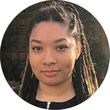- OT
- Life in practice
- Career development
- “Placements like these are vital in showing you how to put what you’ve learnt into practice”
Students in...
“Placements like these are vital in showing you how to put what you’ve learnt into practice”
Third-year student at City, University of London, Camille Wartemberg, on supplementing learning with a visit to a low vision assessment clinic


Camille Wartemberg
22 August 2022
Meet the student
Name: Camille Wartemberg
University: City, University of London
Year of study: Third year
Why I want to become an optometrist: I love human biology and I think eyes and the visual system are the most fascinating part of the body – and the most valuable to many people.
The visit to the Royal National Institute of Blind People (RNIB) was a compulsory component of the third-year binocular vision, paediatrics and visual impairment module. I found it worthwhile to attend to supplement what is taught in lectures and in university clinics. This wasn’t an area I had considered before as low vision was a relatively new area of optometry to me on entering third-year.
On the visit, we got to practise components of a low vision assessment on a patient, including the history and symptoms, measuring visual acuity and contrast sensitivity. We were also given a tour of the RNIB resource centre and shown how to use a wide range of the low vision aids available. I had expected it to be a more observational experience, however, it was quite student-led and hands-on which I enjoyed.
It sounds silly, as it’s a low vision clinic, but I was quite surprised by the volume of low vision aids in the clinic – the tables were completely covered in such a wide variety of magnifiers. I think this made it very accessible for patients to just pick things up and try them out.
My favourite aspect of any placement is the insight you get from meeting clinicians other than your university lecturers, clinic leads and supervisors. It is always interesting and inspiring hearing about their career journeys and getting to watch and learn from them in the context of a clinic dedicated to that specialism.
I hadn’t given much thought to career opportunities at charities within the optical sector before this placement, so it has definitely pushed me to want to explore this further later on
One aspect I found challenging was that sometimes patients are reluctant to do tests that they don’t deem useful. For example, recording near acuities with high magnifiers which have a field of view they might not find comfortable to read with, or recording visual acuity in an eye they subjectively perceive to have very poor vision. It is helpful to provide reassurance.
An insight into future careers
Since starting third-year I’ve found visual impairment to be one of the most interesting modules, so having the chance to see a dedicated low vision service has given me better insight into what a future career in this field is like. I hadn’t given much thought to career opportunities at charities within the optical sector before this placement, so it has definitely pushed me to want to explore this further later on.
Having a wide experience is important because, even if you don’t end up working directly in that area, at some point in your career it might prove useful to be familiar with the services that some of your patients might use outside of your direct care. Additionally, I think it’s always great to supplement your learning by being able to visit organisations that you would otherwise only know by name.
The experience reaffirmed how important it is to listen to patients, understand their priorities, and adapt to these. University teaches you the fundamentals of examining patients, but I think placements like these are vital in showing you how to put what you’ve learnt into practice, adapting it to a wider range of patient types. It was great to gain more experience in examining and communicating with low vision patients as we don’t see many at university. In a way, it brought a lot of aspects of the visual impairment module to life.
I would tell other students…
The setting, with the Royal National Institute of Blind People
Placement: Royal National Institute of Blind People low vision clinic and resource centre
Location: Royal National Institute of the Blind, central London
How many placements or shadowing opportunities do you offer per year and for what duration?
Dr Louise Gow (LG), specialist lead for eye health at the RNIB, and Dr Ahalya Subramanian, visual impairment module lead and associate professor at City, University of London: The opportunity exists for approximately 112 third year students each year. The visit is for two hours and students visit the resource centre to see what kind of aids are available through RNIB, then get to meet a patient at the low vision clinic.
Why does the low vision clinic take on student optometrists?
LG: The partnership emerged from conversations between myself and Dr Ahalya Subramanian, visual impairment module lead and associate professor at City, University of London.
The organisation is keen to provide opportunities for students to see inside a clinic and resource centre, to encourage them to consider working in the field of low vision once they qualify.

Comments (0)
You must be logged in to join the discussion. Log in